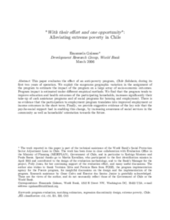The latest World Development Report has brought poverty traps back to the central stage of the development agenda. The dynamic processes through which different groups in society experience persistently diverging income levels are complex. There is a general agreement that household in extreme poverty are deprived along multiple dimensions, which reinforce each other to jointly lock them into indigence. In Appadurai’s words (2004): “Poverty is many things, all of them bad. It is material deprivation and desperation. It is lack of security and dignity. It is exposure to risk and high costs for thin comforts. It is inequality materialized. (..) The challenge today is how to bring the politics of dignity and the politics of poverty into a single framework.” Yet there are very few examples of policy interventions that take this multi-dimensionality seriously, so as to help the extreme poor to escape deprivation in a sustained way by simultaneously addressing different structural constraints.
An important exception approach might come from a new program aimed at tackling extreme poverty in Chile. The country has experienced years of sustained income growth during the 1990s, with an average per capita GDP growth of 4.5 per cent between 1990 and 2002. As a result, in the context of a stable income distribution (Ferreira, Litchfield 1999), economic growth has translated into a reduction in the incidence of overall poverty in the country (from 33 per cent to around 15 per cent), but without much changes in extreme poverty (stable at around 5.6 per cent) over the same period (World Bank 2001). The benefits from growth did not trickle down to the poorest segments of the population despite a large array of social services, targeted to the poor. The poorest segments are often unaware of their eligibility to certain programs or do not know how to activate the process of accessing them. As a response, the government of Chile has proactively introduced in 2002 a program, Chile Solidario, which aims reaching households in ‘indigence’ in the country with an approach that goes beyond improving the targeting performance of public programs or simply providing recipients with cash assistance. The innovative approach involves a two-pronged strategy, working on both the demand as well as the supply side of public services.
The results from the first two years of intervention of the program show gains along different dimensions of education (preschool enrolment, enrollment into school for 6-15, adult literacy) and health (enrolment in the public health system, as well as preventive health visits for children under 6 and women). The results show also a strong take-up of employment programs, though this participation is not (yet) translated into employment effects. There are no significant effects on household income per capita, though participating households are significantly more likely to be receiving social assistance transfers. There is also evidence that on average Chile Solidario participants have increased their awareness of social services in the community and are more likely to be more optimistic about their future socio-economic situation.
The structure of the paper is follows. We start in section 2 with a detailed description of the Chile Solidario program and its assignment mechanism. Section 3 presents the methodology we apply, and discuss the identification assumptions. Section 4 describes the data and section 5 presents the results. Section 6 will explore the extent to which the program effects are correlated with each other and with some key socio-economic characteristics of the participating households. Concluding comments will be provided in section 7.
©World Bank Social Protection Sector

